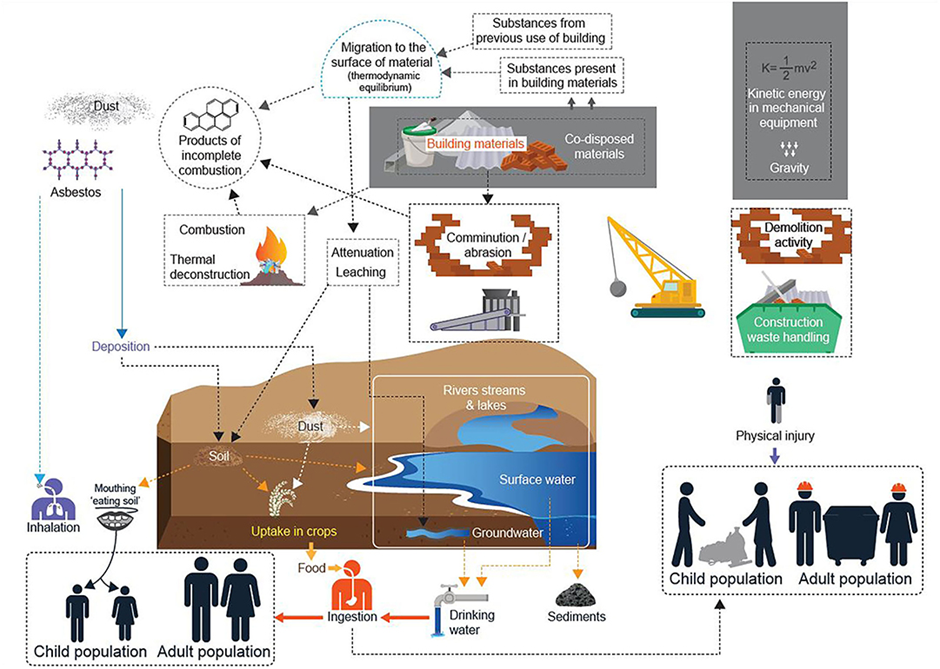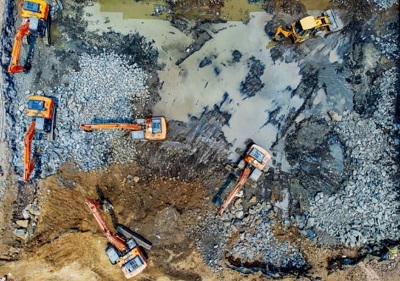Context:
As cities expand and indulge in construction to accommodate more people, the question of dealing with construction and demolition waste becomes increasingly critical.
The Expanding Urban Landscape
- Growing Construction Activities in Cities : Indian cities are continually evolving, with a plethora of construction activities aimed at accommodating a growing population and increasing urban demands. This includes new construction projects, demolition of outdated structures, remodelling of existing buildings, and the erection of taller and more advanced buildings. These projects span a wide range of infrastructure, including residential and commercial complexes, schools, hospitals, roads, bridges, flyovers, tunnels, metros, monorails, and more.
- Construction and Demolition (C&D) Materials : Construction and demolition (C&D) materials are generated during the construction of new buildings and civil engineering projects, as well as during the renovation or demolition of existing structures, including deconstruction activities. Civil engineering projects encompass public works such as streets, highways, bridges, utility plants, piers, and dams.
These materials typically include bulky and heavy substances like concrete, wood from buildings, asphalt from roads and roofing shingles, and gypsum, which is a key component of drywall. Additionally, C&D waste includes metals, bricks, glass, plastics, and salvaged building components such as doors, windows, and plumbing fixtures. It also comprises natural elements like trees, stumps, earth, and rock removed during site clearing.
- The Construction and Demolition Waste Management Rules (C&D Rules) 2016 : In 2016, the Ministry of Environment, Forest and Climate Change introduced the Construction and Demolition Waste Management Rules (C&D Rules) 2016. These rules aim to regulate C&D waste by defining it as waste from construction, remodelling, repair, and demolition activities. They mandate that waste generators are responsible for collecting, segregating, and storing waste, and ensuring it is not deposited in unauthorised locations. Furthermore, urban local bodies (ULBs) are tasked with ensuring proper waste disposal and creating information systems for waste management.
Challenges in Waste Management
- Inadequate Waste Management : Despite existing regulations, construction waste management in Indian cities often remains inadequate. Rules are frequently ignored, leading to significant issues such as the narrowing of water bodies and exacerbation of urban flooding. Waste is sometimes illegally dumped, especially during night hours, along riverbanks, contributing to environmental degradation and increased flood risks. The recent floods in Pune illustrate the dangers of such practices.
- The Issue of Construction and Demolition Waste : As infrastructure ages and becomes obsolete, it must be replaced or demolished to make way for new development. This results in substantial volumes of construction and demolition (C&D) waste. For instance, construction waste comprises materials such as asphalt, cement, bricks, glass, wiring, insulation, rebar, wood, plaster, and scrap metal. Additionally, demolition activities generate dredging materials like rocks, dirt, rubble, and tree stumps. In the United States, construction waste constitutes about one-third of total refuse, while in India, estimates suggest a national annual output of 165 to 175 million tonnes of C&D waste.

Benefits of Minimising C&D Material Disposal
Reducing the disposal of construction and demolition (C&D) materials in landfills or incinerators offers several significant advantages:
- Economic and Employment Opportunities: Emphasising recycling and deconstruction can stimulate local economies by creating jobs in the recycling sector and generating business opportunities. For example, the Environmental Protection Agency's (EPA) 2016 Recycling Economic Information (REI) Report indicated that in 2012, recycling C&D materials supported 175,000 jobs.
- Cost Savings: Reusing and recycling C&D materials can lower overall project costs by avoiding expenses related to material purchases and disposal. Donating recovered materials to 501(c)(3) charities can also provide tax benefits, while onsite reuse reduces transportation costs.
- Environmental Benefits: Fewer disposal facilities can mitigate environmental issues associated with waste management. Recycling C&D materials helps to offset the environmental impact of extracting and using new resources, as well as reduces landfill space consumption.
- Resource Conservation: Salvaging, recycling, and reusing C&D materials conserve virgin resources and minimize the environmental footprint of new material production.
Addressing Construction and Demolition (C&D) Waste
- Optimal Utilisation and Disposal : Given the environmental harm and massive volume of C&D waste, it is crucial to focus on optimal utilisation. This involves reducing, reusing, and recycling materials. For instance, construction debris like wood, plastics, asphalt pavements, and aggregate products can be reused or recycled for new construction projects. Cement, plaster, and bricks can be crushed and repurposed. However, hazardous waste such as treated timber, asbestos, and contaminated soils requires careful disposal according to specific regulations. Effective management of such waste necessitates a strategic approach.
- Flood Line Regulations and Urban Mismanagement : State governments are required to draw flood lines—red and blue—on maps to denote areas prone to flooding. The blue line represents the maximum flood line over 25 years, while the red line denotes the maximum flood line over 100 years. Construction is prohibited in areas up to the blue line, with limited development allowed between the blue and red lines. However, violations are common, and many cities have developed within flood-prone areas. The Centre for Science and Environment reported that between 2005 and 2013, 287 million tonnes of C&D waste were dumped into rivers, causing significant damage to river ecosystems.
- The Need for Recycling Facilities : Few cities in India have established C&D waste recycling facilities, despite the potential profitability and environmental benefits of recycling. The C&D Rules stipulate that ULBs should use 10 to 20 percent of recycled waste in their construction projects. The rules also hold all stakeholders responsible for waste management and make illegal dumping outside designated sites a punishable offence.
What You Can Do?
|
Conclusion
As urban areas continue to expand, managing construction and demolition waste becomes increasingly critical. Given the severe consequences of improper waste disposal, particularly in flood-prone areas, it is imperative to enforce stricter regulations and promote recycling. Effective waste management strategies are essential for reducing environmental impact and mitigating the risks associated with urban flooding.
|
Probable Questions for UPSC Mains
|
Source: ORF India







